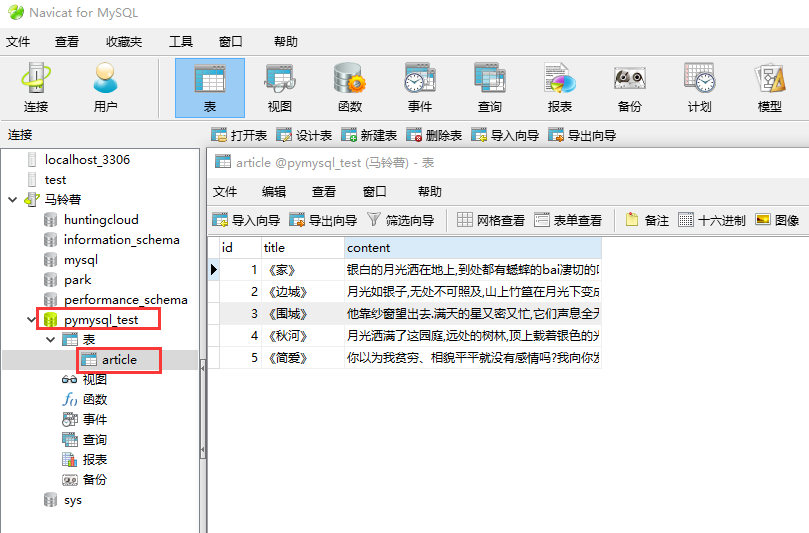MySQL数据库安装
安装教程:https://blog.csdn.net/bobo553443/article/details/81383194
下载那个版本视自己的操作系统和项目要求,不同版本区别不大,建议安装5.6.或者5.7.稳定版本(这里我用的版本是5.7.33.0)
Navicat for MySQL数据库管理软件
安装教程:https://blog.csdn.net/cnds123321/article/details/105704886
相关文档
链接:https://pan.baidu.com/s/1RE36MhnXZNkm9fggfHl8aA
提取码:7wdq
复制这段内容后打开百度网盘手机App,操作更方便哦
驱动程序
Python想要操作MySQL。必须要有一个中间件,或者叫做驱动程序。驱动程序有很多。比如有:
1.mysqldb(只在Python2中有用)
2.Mysqlclient
3.Pymysql
在这里,我们选择用pymysql。安装方式也是非常简单,通过命令:
pip install pymysql
python连接mysql
db = pymysql.connect(host="127.0.0.1",user="root",password="password",database="pymysql_test",charset="utf8",port=3306)
host:以后在连接外网服务器的时候,就要改成外网服务器的ip地址
port:在外网一般会更换端口号,不会为3306,这是为了安全考虑
user:连接的用户,一般在生产环境中会单独分配一个账号给你,而不是使用root用户
database:要连接操作的数据库名
charset:设置为utf8这样就能操作中文了
# python连接mysql import pymysql title = "《"+input("请输入书名:")+"》" content = input("请输入书中的精彩片段:") # 注意:是charset="utf8",而不是"utf-8" db = pymysql.connect(host="127.0.0.1",user="root",password="password",database="pymysql_test",charset="utf8",port=3306) # 创建游标对象(通过游标对数据库进行操作) cursor = db.cursor() # 执行sql语句(将数据插入到article表中) cursor.execute("insert into article set title='{}', content='{}'".format(title,content)) cursor.execute("select * from article") # 查询表carpark里面的数据,并返回二维数据类型 data = cursor.fetchall() print(data) # 提交到数据库 db.commit() # 关闭游标,关闭连接 cursor.close() db.close()

1.MySQL插入数据
第一种方式:
INSERT INTO 表名 SET 列名称 = 列值
第二种方式:
INSERT INTO 表名 VALUES(值1, 值2,....)
INSERT INTO 表名(列1, 列2,...) VALUES (值1, 值2,....)
# 插入数据 import pymysql db = pymysql.connect(host="127.0.0.1",user="root",password="password",database="pymysql_test",charset="utf8",port=3306) cursor = db.cursor() # 1.第一种插入数据的方法 title_1 = "《艳阳天》" content_1 = "五月末的北方夜晚,是最清新、最美好的时刻.天空象是刷洗过一般,没有一丝云雾,蓝晶晶的,又高又远.一轮圆圆的月亮,从东边的山梁上爬出来,如同一盏大灯笼,把个奇石密布的山谷照得亮堂堂,把树枝、幼草的影投射在小路上,花花点点,悠悠荡荡.宿鸟在枝头上叫着,小虫子在草棵子里蹦着,梯田里春苗在拔秆儿生长着;山野中也有万千生命在欢腾着……" cursor.execute("insert into article set title='{}',content='{}'".format(title_1,content_1)) db.commit() print("第一种方式写入成功!") # 2.第二种插入数据的方法 title_2 = "《秋河》" content_2 = "月光洒满了这园庭,远处的树林,顶上载着银色的光华,林里烘出浓厚的黑影,寂静严肃的压在那里.喷水池的喷水,池里的微波,都反射着皎洁的月光,在那里荡漾,她脚下的绿茵和近旁的花草也披了月光,柔软无声的在受她的践踏." sql = "insert into article(id,title,content) values(null,%s,%s)" cursor.execute(sql,(title_2,content_2)) db.commit() print("第二种方式写入成功!") cursor.close() db.close()
2.MySQL删除数据
DELETE FROM 表名 WHERE 列名称 = 值
# 删除数据 import pymysql db = pymysql.connect(host="127.0.0.1",user="root",password="password",database="pymysql_test",charset="utf8",port=3306) cursor = db.cursor() # 删除article表中指定数据 title = "《"+input("请输入要删除的书名:")+"》" print("正在删除删除标题为{}的数据...".format(title)) cursor.execute("delete from article where title ='{}'".format(title)) db.commit() print("删除成功!") cursor.close() db.close()
3.MySQL更改数据
UPDATE 表名称 SET 列名称 = 新值 WHERE 列名称 = 某值
# 更新数据 import pymysql db = pymysql.connect(host="127.0.0.1",user="root",password="password",database="pymysql_test",charset="utf8",port=3306) cursor = db.cursor() # 更新article表中指定数据 title = "《"+input("请输入要修改的书名:")+"》" title_1 = "《"+input("请输入修改后的书名:")+"》" content_1 = input("请输入修改后的书中精彩片段:") cursor.execute("update article set title='{1}',content='{2}'where title='{0}'".format(title,title_1,content_1)) cursor.execute("select * from article where title='{}'".format(title_1)) data = cursor.fetchone() print("数据修改为:",data) db.commit() cursor.close() db.close()
4.MySQL查找数据
SELECT * FROM 表名
SELECT 列名称 FROM 表名 (WHERE 列名称 = 某值)
扩展:使用pymysql查询数据,可以使用以下方法
fetchone():这个方法每次只获取一条数据
fetchall():这个方法接收全部的返回结果
fetchmany(size):可以获取指定条数的数据
# 查找数据 import pymysql db = pymysql.connect(host="127.0.0.1",user="root",password="password",database="pymysql_test",charset="utf8",port=3306) cursor = db.cursor() # fetchone()函数,这个方法每次只获取一条数据 title = "《"+input("请输入要查找书的名字:")+"》" cursor.execute("select content from article where title='{}'".format(title)) content = cursor.fetchone() print("\nfetchone()函数:",content) db.commit() # fetchall()函数,这个方法接收全部的返回结果 cursor.execute("select * from article") content = cursor.fetchall() print("\nfetchall()函数:",content) db.commit() # fetchmany(size)函数,可以获取指定条数的数据,指定两条数据 cursor.execute("select * from article") content = cursor.fetchmany(2) print("\nfetchmany()函数:",content) db.commit() cursor.close() db.close()
对上述python中连接MySQL代码进行封装
#coding=utf-8 import pymysql class mysqlSearch(object): def __init__(self): self.get_conn() def get_conn(self): try: self.conn = pymysql.connect( host='localhost', user='root', password='password', database='pymysql_test', port=3306, charset='utf8', ) except pymysql.Error as e: print(e) def close_conn(self): try: if self.conn: # 关闭连接 self.conn.close() except pymysql.Error as e: print(e) def get_one(self): # 准备sql sql = "select * from news where author= %s order by create_time desc;" # 找到cursor cursor = self.conn.cursor() # 执行sql cursor.execute(sql,('大苏打')) # 输出结果 rest = cursor.fetchall() #输出数据行 print(cursor.rowcount) #处理数据 print(rest) #关闭cursor/连接 cursor.close() self.close_conn() # 添加一条数据 def add_one(self): pass #准备sq #获取cursor def main(): obj=mysqlSearch() obj.get_one() if __name__=='__main__': main()